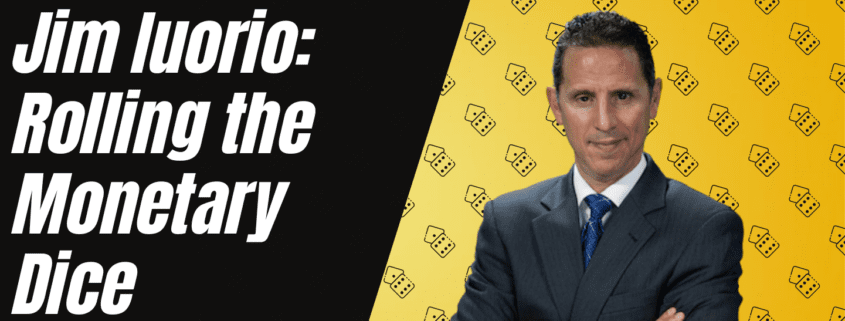Jim Iuorio: Rolling the Monetary Dice
Jim Iuorio joins the podcast to talk about the consequences of deficient spending, how to think about assets like gold and Bitcoin, and why the Fed is rolling the dice with our monetary system.
Additional Resources
The Case for Gold Yield in an Investment Portfolio
Podcast Chapters
[00:00:00]: Jim Iuorio
[00:00:45]: Market conditions and shocks
[00:02:12]: US debt and bond market
[00:02:58]: Labor market analysis
[00:04:25]: Stock market crash and Fed’s response
[00:06:38]: Known unknowns and unknown unknowns
[00:09:13]: Analysis of gold and its performance
[00:12:00]: Bitcoin and Keynes
[00:18:13]: Where to look
[00:20:13]: Subscribe!
Transcript:
BVN:
Welcome back to The Gold Exchange Podcast. My name is Ben Nadelstein. We’re coming at you live from the New Orleans Investment Conference. I’m joined by Jim Iuorio from TJM Investments. Jim, first of all, thank you so much for coming. What have you seen so far that has just absolutely shocked you about the markets? All start, 5 % rates and stock markets near an all time high, unemployment around 3.9 % and inflation actually cooling. What has shocked you about what we’re seeing right now?
Jim Iuorio:
There’s been more shocking things in the last three weeks than I’ve seen in quite a while. The most shocking thing was if you go back to October 11th, when we had a 30-year bond auction. A lot of people don’t pay a lot of attention to the bond auctions, mostly because they’ve been boring for the last 15 years because the Federal Reserve is the one who’s buying the bonds from the treasuries. There’s really no legitimate price discovery. Now the treasury is selling bonds to raise money for government spending. The market told them on October 11th and the 30-year auction that the bonds are not as valuable as they think they are. The treasury thought they’re going to sell them at 4.8%. The market said, We’re not going to pay 4.8, we’re going to pay 4.85. It sounds like a small difference, but now all of a sudden we’re starting to see what the real opinion is of the general market about US debt. What they’re saying is, We are spending too much money and using too much deficit spending to do it. So too many bonds are being sold. And then what was even more interesting is that just last week, it might have been this week, I get to confuse the weeks when I travel.
But this week there was a refunding announcement. So not an actual auction, but when the Treasury comes out and tells you how much they’re going to sell and what durations. The market was relieved that Janet Yellen said, We’re not going to sell too many in the long run. We’re going to concentrate more in the short end. Also in the stock market rallies because of that, which to me is like, if you paraphrase what she’s thinking and saying, it’s like, Yeah, we’re scared to sell long-end bonds because we’re afraid the rate is going to go up too high on those. The price go down, rate go high. To me, that’s amazing. Now you mentioned a bunch of things that the stock market seems to be, I wouldn’t say okay with higher rates, but has not reacted the way it’s not crashed in any way and neither has the economic condition, supposedly. But I don’t agree with that either. I think we’re heading to a recession. I think some of those numbers are either misleading the economic data points are either misleading or possibly even fabricated.
BVN:
Yeah, and I do want to talk about that because your average Joe, your average consumer says, I don’t know, I heard CPIs falling. I heard unemployment is whatever, it’s under five. That’s pretty great. I don’t know, the stock market seems to be doing okay. Then you actually dig into some of these numbers, whether that be unemployment, job statistics, or even inflation stats, and you’re like, Oh, this is just outright incorrect. How can an average person say, Okay, wait a minute, things are going fine on paper, but what’s underneath all that paper?
Jim Iuorio:
Let’s look at the labor, and remember, the labor sector is what they were hanging their hat on for, Oh, there’s no recession. Look, there’s low unemployment. Just to put it in perspective, in the last three months, this is according to the last round of the establishment numbers, and today was a new number today. We’ll get to that in a second. Over the last three months, 700,000 government jobs have been added, 102 private sector full-time jobs, 1.2 million have been lost. The glut of the balance has been made up in part-time work, second jobs, hospitality, when government, like I just mentioned. This to me does not look like a healthy labor market when everybody is a hostess at a restaurant or a DoorDash driver—that to me is outrageous. Now, today the number came in lower than expected. We’re talking on Friday the third. Number came in lower than expected in the unemployment. But the household survey now says that we are losing jobs. To me, that’s a more reliable survey right now. To me that’s a pretty big deal. You said what shocks me? The stock market still looks at that and says, Oh, the economy is crumbling.
Buy it because what they’re saying is the Federal Reserve is going to be easier. Just in the last week, we went from pricing in 45 basis points of easing in 2024. I’m talking about the futures market. Now it’s pricing in 100 basis points of easing in 2024, just since Monday.
BVN:
I do wonder, is this narrative, hey, if something goes wrong, which we all think something’s about to go wrong, if something does really go catastrophically wrong, there’s no shot that the Fed will say, Oh, you’re going to take those losses. It’s going to be like we’ve always seen, which is bail-ins, borrowing, and just saying, Hey, too big to fail. Is the stock market just saying, We know you will never let us fall. Is there really ever going to be a stock market crash?
Jim Iuorio:
Yes, there is. But can they extend and pretend longer this time? I don’t know if you just said, I was just on a paddle with Dave, Colin, Peter, Bookvar, and Len Alden. I believe, Jay Powell talks tough, and it’s easy to talk tough when things are going okay. It’s harder to talk tough when burning timbers are falling from the roof. Mike Tyson’s quote, Everybody has a plan until they get punched in the face. Jay Powell hasn’t been punched in the face yet, so he can talk tough about keeping rates lower for longer. But all of a sudden, we saw that little fissure in the banking system back in March with SVP and what was the other one? Republic Bank. And this is a big deal. These banks have US treasuries on their books, and they have them to hold the maturity corral so they don’t have to mark them to market. Mark to market. All of a sudden, we should ring a bell. That’s what we were always talking about in 2006 and 2007 because no one had to mark to market their security. But if they did, Bank of America, supposedly Bank of America has a… I don’t know what words I can use that aren’t cuss words.
Jim Iuorio:
They have a lot. They have a lot of bonds. So a lot of these banks are probably, insolvent might not be the right word, if they were made to market all the securities that they hold. So the point I’m trying to make is just because you can’t see where the crisis is coming from doesn’t mean there’s not a lot of crises out there that could come.
BVN:
I do want to talk quickly about known knowns. These are things we know this is what the print was or this is what we think is going to happen. Then there’s those known unknowns. We know that there’s something brewing in, let’s say, commercial real estate, but we don’t know how big it is. Then there’s those unknown unknowns, things that we haven’t even thought to think about. For people who are looking around, what are some things that you’re looking at that might be known unknowns or even unknown unknowns.
Jim Iuorio:
Right now? I’m going to go back to… I’ll give a statistic real quick. Our debt to GDP ratio in this country has gone to 130%. Over the last 120 years, there’s been 53 countries that have gotten to that level of debt to GDP. 52 of those countries have defaulted. Now, some of those defaults were wild inflation or hyperinflation just to inflate away the debt and have it be seem like nothing in the terms of the new world after inflation. The only one that’s been able to extend and pretend again has been Japan. They’re the 130. We have reached that level, too. The way I think it is going to play out is that if the market still keeps telling the US Treasury that we’re not going to buy your bonds at the right… We have a price for your bonds, but it’s a much lower price than you think, then I think the Fed will quietly end its quantitative tightening program, which by the way, we were just in that panel entire. I’m not sure a lot of people get what the quantitative tightening is. To make it simple for the people who are watching some of them, the Fed used to buy bonds.
They wanted the price of bonds to go up. For 15 years, they were buying bonds from the US Treasury. Now, they’re not actually selling the ones they own, but the ones that are expiring, they’re just taking the coupon back, and then the treasury has to go out and sell another bond to replace it. They’re just getting the payment back. Basically, just think of it easily as the Fed is putting pressure on the bond market. They’re not actually selling bonds, but they’re selling bonds. That’s a quantitative opportunity. I believe they’ll stop that and they’ll start re-investing the proceeds. Then if things start to really get dicey, they’ll get back in the buying bonds game, which then what we are going to see is the currency start to be devalued and none of this nonsense about the currency in the dollar index rallying because that’s just measured against other countries that are doing the same nonsense that we are. That’s one of the reasons I came here to this conference to speak about assets that could do well and that gold being somewhere near the top of that list.
BVN:
Let’s jump to assets. I want to do an underappreciated or underpriced versus overpriced and overappreciated, maybe overhyped. We’ve heard a lot of talk about gold. Now the first thing is gold is holding up incredibly well against high interest rates. Now, monetary metals will pay interest on gold. There is some competition there, but gold is holding up against real rates and holding up against inflation and these more classic cases for gold, geopolitical risk, things like that. Do you see gold is just waiting to break out here? Or do you think that now this has just been a lucky turn of events for the gold price?
Jim Iuorio:
To me, it’s the latter because it’s coiled. You mentioned real rates, and for those listing real rates are the nominal rate of a treasury minus inflation expectations. The real rate now in the US 10 year is about 2%. Inflation expectations might be nonsense, but that’s what the real rate is right now. Real rates being high and above zero has been death to gold historically. Gold hates real rates. Gold’s held in quite nicely despite the fact of real rates. To me, that is something that indicates a coiling, waiting for the right atmosphere to explode. That was my base case for gold. That’s why I bought it. Now the thing about gold, too, is it rallied 100 bucks in the first couple of weeks of October. Every pundit on these news stations were saying gold’s rallying because of a flight’s quality, because of global unrest, nonsense. When gold started rallying was not on October seventh when that happened. It was October 11th when the bond auction went poorly and when we started talking about the numbers that the US is going to borrow to send aid to war on two fronts.
BVN:
Janet Yellen, in an interview, says, We have an unlimited capacity to fund two foreign wars. Now, regardless of whether your opinion’s on the geopolitical question, the domestic question of unlimited support in terms of monetary stimulus and funding and increased debt made most people who own gold say, if I don’t own some now, I’m sure as heck going to buy some.
Jim Iuorio:
And that’s when it rallied. So that’s exactly what it was. And for her to say that this is the same modern monetary theory nonsense that’s been hanging around like a, I thought there’s metaphors that I can’t say on your podcast. You would have loved them.
BVN:
Believe in your mind that we’re-.
Jim Iuorio:
Believe in your mind. They’re hanging around and people believe that the federal government can just keep deficit spending. And if they ever see inflation, that they have the tools to fight it real quickly. I challenge that on so many fronts, they don’t even have the capacity to notice inflation and notice when it’s persistent. In June of 2021, CPI printed over 5%. The housing market was inarguably on fire. And the Fed’s response to it was one, to call it transitory in the press, and two, to absolutely hit the gas with their bond buying program, turning a small fire into a blaze. So modern monetary theory is stupid. It’s so sexy and seductive to politicians because they’re like, Wait, I can spend as much money as I want. No worries. Yeah, guess what they’re going to do. That’s what they’re going to do.
BVN:
Well, and Japan is a classic example. Well, look, Japan’s fine. Japan is not fine. If you want our economy to look like Japan, you are a moron. They are not an exemplar of what we should do with our economy. They are a current case of what could potentially happen if we keep on this. And as you mentioned in that crazy statistic, they are just waiting to become that next currency or that next country to default. They are not someone that we should be emulating in any fashion.
Jim Iuorio:
I don’t think you need me on this podcast because yes, I think you underscore that, put an exclamation point, it’s 100 % true.
BVN:
All right, now let’s see if we can find a little disagreement. I’m not a big cryptocurrency guy. I know I’m young and you would think I’m all about crypto, but I don’t see how crypto, which has held on quite well actually here reaches new all time highs. Do you see that there’s a narrative brewing for crypto here or do you think the gas has been let out of the bubble?
Jim Iuorio:
Okay, so there’s definitely a narrative building. And Bitcoin is one of the best performing assets of the year, up 110 %. Last I checked. The story to me is these major Blueblood institutions getting involved in crypto. Blackrock at the top of the list, but Wisdomtree, Fidelity. Everyone is expanding their footprint into Bitcoin. So six months ago, eight months ago, I realized that my opinion on Bitcoin doesn’t matter. If BlackRock likes Bitcoin and BlackRock is expanding, they must think… I lived near a horse racing track when I was a kid. Oh, here we go. This is old man meandering.
BVN:
This is why.
Jim Iuorio:
We have Jim on it. Right, okay. And all we would do is hang by where the real horse players were. This is when we were kids where they’d take a bet when you were 14 years old. I don’t think there was an age limit. They’d also sell you a beer when you’re 14 years old. All we would do is sand by the fence where on the other side the real horse players were, and listen to that. This is where I am with Bitcoin and the late money is born. And all of a sudden, BlackRock, who is our overlords, again, we could talk about that for a long time too, them expanding their footprint in the Bitcoin has made me interested in it. Its performance this year has made me interested in it. I’ve increased my exposure to bitcoin. In some ways, I hope I lose every bit of it, because if it explodes to new highs, it’ll mean all the bad things we are talking about are probably coming to root. That scares me a little bit. Am I a fan of bitcoin? I barely even know what Bitcoin is. Am I invested in it?
Jim Iuorio:
Am I going to continue to invest in it? Absolutely, I am, but it’s for non-traditional reasons.
BVN:
Right, okay. Final question here. We’re looking at assets like gold, bitcoin, these flights to quality, it’s been called, or flights to safety. I might have disagreement, but that’s fine. Question here. Do you see the dollar and treasury bills, T-bills, as a part of that flight to safety trade? Countries like the Juan, the Rubel, the Yen. People are going to say, Why would I invest in a Brazil when I can just get 5% on T-bills? Do you see T-bills as a flight to safety.
Jim Iuorio:
As well? Yes, but that’s the problem that I’m seeing. If it changes, if people are backing away from buying T-bills because the risk of that too much issuance is going to stomp the price, that’s when these assets could really explode. The non-dollar, non-T-bill assets. Again, we’re the reserve currency, and when things hit the fan globally, people rush to the dollar and they rush to treasures. By the way, they didn’t really buy treasuries after the October seventh invasion of Israel. They didn’t really buy treasuries, which to me was very significant. But the dollar part of it, the dollar is still the reserve currency. The dollar’s chances of not being the reserve currencies are still quite small. But when you look back to a year ago, February, when Russia invaded Ukraine, and our response was to lock up Russia’s treasuries, kicked them out of the Swift payment system, lock up all the dollar-denominated assets. That’s not something that a good auditor of the world’s financial transactions does because it’s viewed as- It’s a precedent. It’s a precedent. So that’s in the last in2022, world central banks bought the most gold they’ve bought in 75 years. I’m sure you know that.
Jim Iuorio:
You work for a company called Monetary Metals. In 2023, they’re on the same pace. This is a way of central banks to say, Do we trust the dollar? Yeah. You know what I mean? Wink. Yeah, we trust the dollar. I will say that to put it in perspective of this, if a currency crisis or a debt crisis, a domestic US those things. If the chances of that, when I was here four years ago, I said, Here’s what’s concerning me. The chances of a debt crisis or currency crisis used to be 0.1 of a % in the next 10 years. If those went to 3 %, that’s significant. Now I put it at 15 %. It’s still 15 %. This is just me, my thumbnail. That’s significant. Actually, it’s appalling that they would start rolling the dice with such a brilliant monetary system where US treasures were the, it’s funny we call it the gold standard. The gold standard, right? Yeah, right. I’m sure you love that. The gold standard, the dollars, the gold standard. The fact that they’re messing with that and playing with that to me is appalling. And it means to me there’s four ways to look at these assets: trade, invest, hedge, or dig a bunker and jump in.
I’m not saying dig a bunker and jump in, but I’m saying that hedging might be the way to go with this. Again, if people listen to me and think I sound like a financial prepper, fine, because I guess I am a little bit of financial prepper. I’d rather be prepared than not. But just also remember, there’s a lot of people like me out there and that could move these asset prices and people could benefit that just even though they don’t believe it.
BVN:
Right. I do think there’s this idea of a Keynesian beauty contest, which it’s not who I think is the most pretty, it’s who I think other people will think is the most pretty. And so we’re not really betting on the idea or the theory or the actual quality. We are betting on the psychology of other market participants and what they believe other market participants believe about the quality. And that’s why something like a Bitcoin or even a gold or a T-bill can have a psychological movement instead of an actual true value movement.
Jim Iuorio:
Amen. Did you make up that.
BVN:
Keynesian beauty contest? No, I wish I did. Unfortunately, the evil Lord Keynes made it up.
Jim Iuorio:
Okay, right. Because I love that because that’s very true. Yeah, exactly. That’s what momentum and technical trading are. And again, I know you’ve listened to our podcast before, we’ve talked about it, but I always described myself as 60-70 % technical analysis, 30-40 % fundamental analysis, because you can look at a fundamental picture and that if the rest of the world doesn’t agree with you and doesn’t agree with you in your time frame, you are wrong. You can be the one guy standing against the herd going, This is stupid, and you’re still trampled. So yes, I’m going to pretend I made up Keynesian Beauty Contest forever. Please do. Do not credit me. This is my way. So yes, it’s like a Keynesian Beauty Contest. You ever heard that expression?
BVN:
No, it’s really fun. I’m going to steal that. Thanks. Okay, as we’re coming to an end here. I want to know what are you reading? What are you looking at? What are some indicators that you’re watching? And also who are you listening to? Other than the Gold Exchange podcast and myself, where are you actually looking for indicators and information about what’s.
Jim Iuorio:
Going on now? I don’t want to leave anybody out because I got my top 10 of people who I listen to everything they say. Brian Westbury jumps to mind, Joe LaVornia jumps to mind. I’m having a brain freeze here. Guys like Peter Bookvar. Peter Schiff. I love Peter Schiff, and I agree with about 80 % he says. Sometimes I speak with less 100 % certainty that he does. And sometimes I think… I’m talking softer guys because he’s standing right over there. I’m not insulting. I’m just saying that to be certain of something to me seems like not the right way, and that’s where I would push back on him. But I listen to him as well. Yeah, well, that’s my show list. Danielle Di Martino-Bouc. She’s going to be at this conference as well.
BVN:
You said we just had her on.
Jim Iuorio:
Yes, what I try to do, and when I gave my speech yesterday, we’re at this conference and we’re all hard money people. We sometimes think the same way, and I always try to fight my own bias. Then I do try to listen to people who are Rosar, who paint a better picture, Joe Brucellus, who is not a big name economist. He’s the economist for RSM, used to be McGladry, the consulting firm. I think he has this positive take on things that I listen to every day just to where do you poke holes in what I’m thinking?
BVN:
Bob Elliot.
Jim Iuorio:
Another good guy. Bob Elliot. I love Bob Elliot.
BVN:
Good. Bob’s a great guy. I’ve been on the podcast. I’m like, Oh, every time I’m feeling low, I listen to Bob
Jim Iuorio:
Right. Or Ryan Dietrich, too. Yes. Yeah, he’s a feel good guy. I’m not even saying he’s wrong. He’s a good one. Yeah, he’s a good one.
BVN:
Yeah, right. Yeah, and having analysis that not only contradicts what you think, but pushes against. I know, Keith, Brent, Johnson, these are guys who are like, Hey, if you think dollar treasuries are falling, this is why you should look at this. It’s nice to have that challenge. Even if you don’t necessarily change your mind, you do need to hear if you’re going to be an intelligent investor, you need to know all angles, even if you.
Jim Iuorio:
End up disagreeing. Right. By the way, I forgot Brentjohnson, I forgot Keith, and I forgot Luke Roman. These are guys where they say anything they say, I listen to every word of it.
BVN:
Yeah, absolutely. Where can people find more of your work and if they want to get involved with you- I just.
Jim Iuorio:
Steal other people’s work, but here you are.
BVN:
Where can they get involved with your work.
Jim Iuorio:
And other people’s work? I post things on Twitter @jimurio and my thoughts on economic conditions. You’re going to get my thoughts on too many things, by the way, and if I irritate you, fine. You can always push back. But at Jim Uriel, and I love when people interact because I think there are so many people out there who have different points of view and who’ve maybe been in finance. Because be wary of the people like myself who’ve been in media for 20 years because sometimes we start to believe the things we say, and you need to surround yourself with people who think other things. But come to me at Jim Murial.
BVN:
Jim, I want to thank you so much for joining us on the Gold Exchange Podcast. We love having you, and I’m sure we’ll have you back.
Additional Resources for Earning Interest in Gold
If you’d like to learn more about how to earn interest on gold with Monetary Metals, check out the following resources:
In this paper, we look at how conventional gold holdings stack up to Monetary Metals Investments, which offer a Yield on Gold, Paid in Gold®. We compare retail coins, vault storage, the popular ETF – GLD, and mining stocks against Monetary Metals’ True Gold Leases.
The Case for Gold Yield in Investment Portfolios
Adding gold to a diversified portfolio of assets reduces volatility and increases returns. But how much and what about the ongoing costs? What changes when gold pays a yield? This paper answers those questions using data going back to 1972.











Leave a Reply
Want to join the discussion?Feel free to contribute!